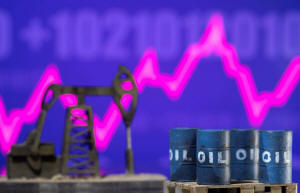|
Brent crude futures rose 14 cents, or 0.2%, to $82.84 a barrel
by 1055 GMT and U.S. crude futures added 1 cent to $77.29.
Gains in the dollar weighed on prices. A stronger dollar can
weaken oil demand because it makes the commodity more expensive
for those holding other currencies.
Federal Reserve Chair Jerome Powell on Wednesday said that the
U.S. central bank will raise interest rates further next year,
even as the economy slips towards a possible recession.
"The oil price is under pressure today as the Fed's hawkish
guidance for its monetary policy sparked renewed concerns about
economic growth, lifting the U.S. dollar and sending commodity
prices down," said CMC Markets analyst Tina Teng.
Chinese economic data for November was "much lower than
expected, further darkening the demand outlook", Teng added.
The world's second-biggest economy lost more momentum as factory
output slowed and retail sales extended declines, both missing
forecasts and clocking their worst readings in six months as
COVID-19 cases surged.
Also weighing on oil prices, Canada's TC Energy Corp said it is
resuming operations in a section of its Keystone pipeline, a
week after a leak of more than 14,000 barrels of oil in rural
Kansas triggered the whole pipe's shutdown.
Lending some support were projections from the International
Energy Agency, which expects Chinese oil demand to recover next
year after a contraction this year of 400,000 barrels per day.
Meanwhile, U.S. crude oil stockpiles rose by more than 10
million barrels last week, the most since March 2021, the Energy
Information Administration said. [EIA/S]
Goldman Sachs on Wednesday reduced its oil price forecasts for
2023, citing a projected market surplus early next year as
supply from Russia remains robust and China demand ramps up.
(Reporting by Noah Browning and Jeslyn LerhAdditional reporting
by Laura Sanicola in WashingtonEditing by David Goodman)
[© 2022 Thomson Reuters. All rights
reserved.]
This material may not be published,
broadcast, rewritten or redistributed.
Thompson Reuters is solely responsible for this content.

|
|





